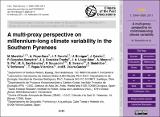Por favor, use este identificador para citar o enlazar a este item:
http://hdl.handle.net/10261/93488COMPARTIR / EXPORTAR:
 SHARE
BASE SHARE
BASE
|
|
| Visualizar otros formatos: MARC | Dublin Core | RDF | ORE | MODS | METS | DIDL | DATACITE | |

| Campo DC | Valor | Lengua/Idioma |
|---|---|---|
| dc.contributor.author | Morellón, Mario | - |
| dc.contributor.author | Pérez-Sanz, Ana | - |
| dc.contributor.author | Corella, Juan Pablo | - |
| dc.contributor.author | Catalán, Jordi | - |
| dc.contributor.author | González-Trueba, J. J. | - |
| dc.contributor.author | López Sáez, José Antonio | - |
| dc.contributor.author | Moreno Caballud, Ana | - |
| dc.contributor.author | Pla-Rabes, Sergi | - |
| dc.contributor.author | Serrano, Enrique | - |
| dc.contributor.author | Valero-Garcés, Blas L. | - |
| dc.date.accessioned | 2014-03-12T11:59:33Z | - |
| dc.date.available | 2014-03-12T11:59:33Z | - |
| dc.date.issued | 2011 | - |
| dc.identifier.citation | Climate of the Past 7: 3049-3089 (2011) | - |
| dc.identifier.issn | 1814-9340 | - |
| dc.identifier.uri | http://hdl.handle.net/10261/93488 | - |
| dc.description | Morellón, Mario et al. | - |
| dc.description.abstract | A review of selected, well-dated, multiproxy paleoclimatic records (lacustrine, dendrochronological, geomorphological) characterizes the main environmental changes occurred in the Southern Pyrenees during the last millennium. Warmer and relatively arid conditions prevailed during the Medieval Climate Anomaly (MCA, <1300 AD), with a significant development of xerophytes and Mediterranean vegetation and limited deciduous tree formations (mesophytes). The Little Ice Age (LIA, 1300-1800 AD) was generally colder and moister, with an expansion of deciduous taxa and cold-adapted mountainous conifers. Two major phases occurred within this period: (i) a transition MCA-LIA, characterized by fluctuating, moist conditions and relatively cold temperatures (ca. 1300 and 1600 AD); - (ii) a second period, characterized by coldest conditions and higher humidity, coinciding with maximum (recent) glacier advances (ca. 1600-1850 AD). After the LIA a warming and more arid phase started coinciding with glacier retreat, and interrupted by a short-living cooling episode during the late 19th to early 20th centuries. Some records suggest a response to solar activity with colder and slightly moister conditions during solar minima. Centennial-scale hydrological fluctuations are in phase with reconstructions of NAO variability, which appears to be the main forcing for humidity in the region during the last millennium. © 2011 Author(s). | - |
| dc.description.sponsorship | This research has been funded by the Spanish InterMinistry of Science and Technology (CICYT), through the projects LIMNOCAL (CGL2006-13327-C04-01), GLOB-ALKARST (REN2003-09130-C02-02), GRACCIE-CONSOLIDER (CSD2007-00067), DINAMO (CGL2009-645-07992) and CRYOMONT (CGL2010-19724). Additional support was provided by the Spanish National Parks Agency through the project HORDA (083/2009). M. Morellón is supported by a Postdoctoral fellowship funded by the Spanish Ministry of Education and Science through FECYT (Spanish Foundation for Science and Technology). A. Perez-Sanz is supported by a pre-doctoral fellowship funded by the Regional Aragonese Government and A. Moreno acknowledges the “Ramón y Cajal” postdoctoral program for funding. | - |
| dc.publisher | Copernicus Publications | - |
| dc.relation.isversionof | Publisher's version | - |
| dc.rights | openAccess | - |
| dc.title | A multi-proxy perspective on millennium-long climate variability in the Southern Pyrenees [Reseña bibliográfica] | - |
| dc.type | reseña de libro | - |
| dc.identifier.doi | 10.5194/cpd-7-3049-2011 | - |
| dc.relation.publisherversion | http://dx.doi.org/10.5194/cpd-7-3049-2011 | - |
| dc.date.updated | 2014-03-12T11:59:33Z | - |
| dc.description.version | Peer Reviewed | - |
| dc.language.rfc3066 | eng | - |
| dc.rights.license | http://creativecommons.org/licenses/by-nc-sa/3.0/es/ | - |
| dc.contributor.funder | Ministerio de Ciencia y Tecnología (España) | - |
| dc.contributor.funder | Ministerio de Agricultura, Alimentación y Medio Ambiente (España) | - |
| dc.contributor.funder | Gobierno de Aragón | - |
| dc.identifier.funder | http://dx.doi.org/10.13039/501100006280 | es_ES |
| dc.identifier.funder | http://dx.doi.org/10.13039/501100004336 | es_ES |
| dc.identifier.funder | http://dx.doi.org/10.13039/501100010067 | es_ES |
| dc.contributor.orcid | López Sáez, José Antonio [0000-0002-3122-2744] | - |
| dc.contributor.orcid | Morellón, Mario [0000-0003-2067-2202] | - |
| dc.contributor.orcid | Pérez-Sanz, Ana [0000-0002-7884-8699] | - |
| dc.contributor.orcid | Corella, Juan Pablo [0000-0001-5127-9011] | - |
| dc.contributor.orcid | Catalán, Jordi [0000-0002-2934-4013] | - |
| dc.contributor.orcid | Pla-Rabes, S. [0000-0003-3532-9466] | - |
| dc.contributor.orcid | Valero-Garcés, Blas L. [0000-0003-2214-7057] | - |
| dc.type.coar | http://purl.org/coar/resource_type/c_ba08 | es_ES |
| item.openairetype | reseña de libro | - |
| item.grantfulltext | open | - |
| item.cerifentitytype | Publications | - |
| item.openairecristype | http://purl.org/coar/resource_type/c_18cf | - |
| item.fulltext | With Fulltext | - |
| Aparece en las colecciones: | (CCHS-IH) Artículos (CEAB) Artículos (IPE) Artículos | |
Ficheros en este ítem:
| Fichero | Descripción | Tamaño | Formato | |
|---|---|---|---|---|
| Multy_proxy_perspective_MorellonM.pdf | 5,47 MB | Adobe PDF |  Visualizar/Abrir |
CORE Recommender
Page view(s)
425
checked on 18-abr-2024
Download(s)
205
checked on 18-abr-2024
Google ScholarTM
Check
Altmetric
Altmetric
Este item está licenciado bajo una Licencia Creative Commons

